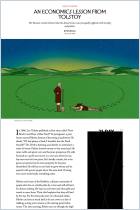Why is the US economy so cutthroat? Is its harsh nature just an inevitable feature of capitalism? In this intriguing text, American journalist Nick Romeo travels to Austria, Spain, and Portugal, seeking alternatives to America’s dog-eat-dog economic ethos. In Austria, he finds a program that guarantees a job to anyone who wants one. In Spain’s Basque Country, he tours a thriving cooperative conglomerate. And in Portugal, he attends budget hearings in which citizens propose public projects based on their priorities. Through his travels, he draws a road map to a kinder, gentler form of capitalism.
Mathematics has come to dominate the field of economics.
The top economic minds of the 18th, 19th and early 20th centuries — such as Adam Smith, Karl Marx, and John Maynard Keynes — saw their discipline as intrinsically linked to others, including history, politics, ethics, and psychology. In recent decades, however, economics has become synonymous with the study of just one field: high-level mathematics. In the early 2000s, a survey of graduate students in economics revealed that an overwhelming majority saw “excellence in mathematics” as a vital element of their training but viewed “a thorough knowledge of the economy” as unimportant. As a handful of top economists now admit, economics’ isolation from other disciplines and its divorce from the practical realities of working people played a big part in the policies that led to the 2008 financial crisis. Just a few years before the crash, University of Chicago economist Robert Lucas opined that the study of wealth inequality had no place in modern economics, labeling focus on the issue “poisonous.”
The shift away from...
Nick Romeo covers economic policy for The New Yorker and teaches at the Graduate School of Journalism at the University of California, Berkeley. He has written for The New York Times, The Washington Post, and National Geographic.











Comment on this summary or Start Discussion